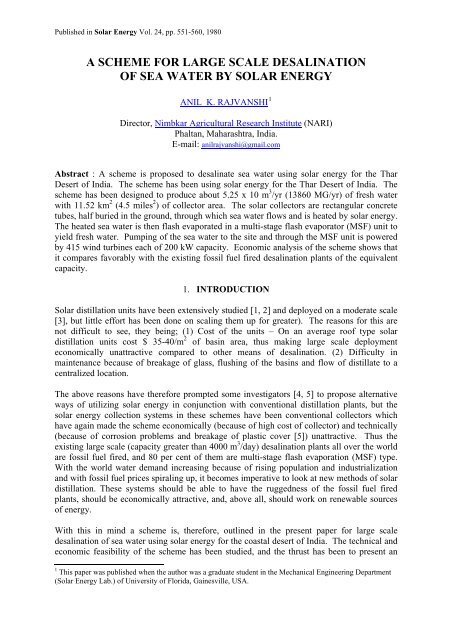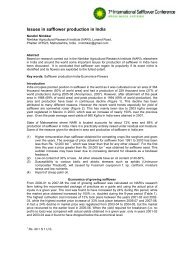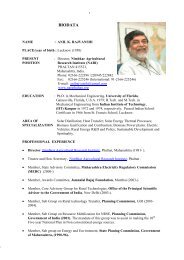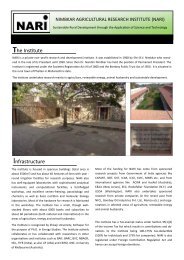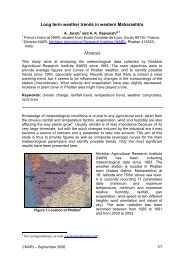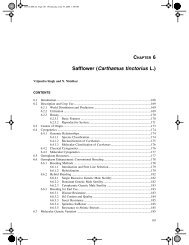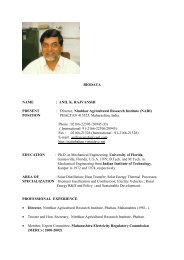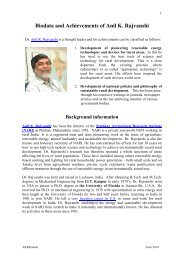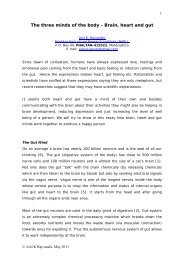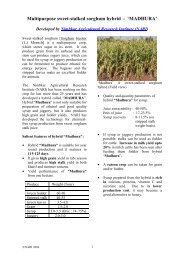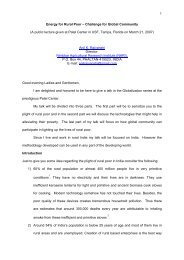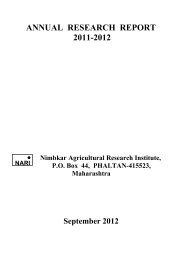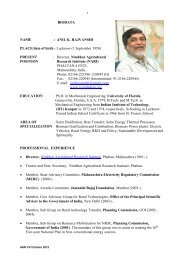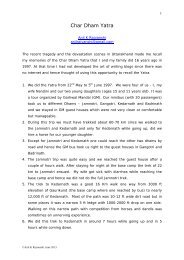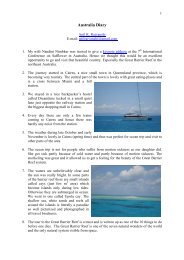Large Scale Desalination of Sea Water Using Solar Energy - NARI
Large Scale Desalination of Sea Water Using Solar Energy - NARI
Large Scale Desalination of Sea Water Using Solar Energy - NARI
- No tags were found...
Create successful ePaper yourself
Turn your PDF publications into a flip-book with our unique Google optimized e-Paper software.
2overall objective rather than detailed design and cost calculations. Thus, an attempt has beenmade to present only the results <strong>of</strong> preliminary design and cost calculations.2. THAR DESERTThe northwest region <strong>of</strong> India is covered with a large desert known as the Thar Desert, whichoccupies an area <strong>of</strong> about 200,000 sq.m. [6]. Figure 1 shows the location <strong>of</strong> this desert andthe proposed site for the desalination unit. The desert is inhabited by about 3 million people,most <strong>of</strong> whom eke out a modest existence through subsistence agriculture [7]. The averageannual precipitation is about 150 mm, the monsoon months being from late July to earlySeptember; most <strong>of</strong> the deep wells are saline; and the water table is very low, in some placesas deep as 100-200 m. In some locales it has not rained for the past 80 yr [8]. There isalways the threat <strong>of</strong> famine in this area resulting in great loss <strong>of</strong> animal and human life.Nevertheless, through the ages local population has been able to identify and use some <strong>of</strong> thewild plants that grow in this area [9]. These plants grow with very little water availableduring the monsoon months, and it is hoped that if adequate water is available in this regionthen the quantity <strong>of</strong> such food together with other staple foods like Bajra can be greatlyincreased. Such optimism is also borne by the past history <strong>of</strong> the region, which indicates that,the confluence <strong>of</strong> man and nature has turned this rich area <strong>of</strong> flourishing Harrappian cultureinto desert [10].Several schemes for watering this area have been proposed, but most <strong>of</strong> them have proven tobe economically unfeasible. Among one <strong>of</strong> the schemes that is being actively pursued by theGovernment <strong>of</strong> India is the construction <strong>of</strong> a huge canal known as the Rajasthan Canal. Thiscanal, when completed, will be able to irrigate a substantial portion <strong>of</strong> the northern part <strong>of</strong> thedesert, but the scheme has been bogged down by rising cost <strong>of</strong> the canal and the lowering <strong>of</strong>the level <strong>of</strong> the Sutlej River, the source <strong>of</strong> this canal.
5and,m c p {T out (t) – T in (t)} = h 1 A i {T 1 (t) + T 2 (t) – T mm (t)} (4)T mm (t) = [T out (t) + T in (t)] /2.0 (5)It should be noted that steady state calculations have been made for the heat flow in thecollector from the top. There will be a thermal lag in the heat transfer to water because <strong>of</strong>absorption <strong>of</strong> heat by the pipe during the warm-up period in the morning. This heat gain willhave a tendency <strong>of</strong> being lost during the afternoon cooling-<strong>of</strong>f period. However, the internalheat transfer coefficient h i inside the pipe is about 448 W/m 2 – 0 C as compared to externalheat transfer coefficient, h 0 <strong>of</strong> 33.6 W/m 2 – 0 C and thus most <strong>of</strong> the energy absorbed in thewalls <strong>of</strong> the pipe is transferred to the water.The base temperature T b (t) is calculated after knowing the soil surface temperature T s (t).Following the method outlined in [15] we find that the diurnal variations <strong>of</strong> the temperaturedies down after about 0.8 m below the surface and is a constant 12.7 0 C (55 0 F).Hence the sand surface temperature in the desert is given by the following equation for perunit area,α sand q'' (t) = h [T s (t)- T ∞ (t)] + (k sand /ΔX) [T s ( r) – 12.7] (6)Where ΔX = 0.8 m.Knowing q'' (t) and T ∞ (t) one can calculate T s (t) easily. There is a time lag between themaximum surface temperature and the maximum temperature 8.9 cm (3.5 in.) below thesurface and is given by [15],ξ = (l/2) [24/(ΠA)] 1/2 (7)Where l = depth below the surface and A = K s /(C p ρ) s . For the present case ξ is 3.7 hrs.Also the maximum temperature T b is given byT b, max = T s, amp exp {- l (Π/A) x 24] 1/2 }, (8)Where T s amp is the amplitude <strong>of</strong> the diurnal variation <strong>of</strong> soil surface temperature. For atypical day in June the top surface temperature, T s and T b are shown in Fig. 5. Table 2 liststhe property values used in the calculations above.Thus knowing the bottom temperature T b (t), eqns (1) - (5) have been solved to yield thetemperature <strong>of</strong> the outlet water from the solar collector. T out (t) from eqn (4) then becomesT in (t) for the next section <strong>of</strong> the collector, and thus the calculations proceed for the totallength <strong>of</strong> the collector. For a typical day in June the outlet temperature from the solarcollector is shown in Fig. 6. The inlet temperature to the solar field is a function <strong>of</strong> the outlet
6temperature. This relationship, shown in Fig. 7, can be calculated by making an enthalpybalance on the distillation unit [16]. In the above calculations it is assumed that the bottom<strong>of</strong> the collector temperature is the same as that <strong>of</strong> sand at depth <strong>of</strong> 8.9 cm, but which isexposed to solar radiation directly. In actual practice the bottom <strong>of</strong> the collector will becooler than the adjacent sand because <strong>of</strong> shading. However, heat loss calculations from thecollector to sand using temperature <strong>of</strong> 49 0 C (120 0 F) for a typical day in June at 2 p.m. yieldheat flow <strong>of</strong> about 480 W/m 2 . This heat loss is about 240 W/m 2 less than that from thecollector bottom, which is shaded. The above heat flow was estimated assuming the sametype <strong>of</strong> temperature pr<strong>of</strong>ile <strong>of</strong> the sand parallel to collector, as that <strong>of</strong> the ground. Correctionsfor the above pr<strong>of</strong>ile were made since the heat is conducted from both ends <strong>of</strong> the collector.The above heat loss translates into loss <strong>of</strong> distillate output <strong>of</strong> 10 per cent which is within theaccuracy <strong>of</strong> most heat transfer calculations. This then justifies the assumption <strong>of</strong> T b .Naturally, the above loss sets the upper limit on the heat flow to the sand and at other times itwill be much less and consequently the distillate loss will be much lower.
7The above set <strong>of</strong> calculations have been done for a typical day in January (the coldest month)and for March, and the outlet temperature-time history is shown in Fig. 6.<strong>Desalination</strong> unitThe heated seawater from the “solar field” goes to the desalination unit for production <strong>of</strong>fresh water. The desalination unit is the regular multi-stage flash evaporation (MSF) type.Normally, these MSF units are used for brine temperatures <strong>of</strong> approximately 100 0 C (212 0 F)and thus would seem inappropriate at a first glance, for our scheme where the maximumbrine temperature is 60 0 C (140 0 F). Nevertheless, in the absence <strong>of</strong> any other viabledesalination technology we have used this system. We do, however, feel the need <strong>of</strong> betterand more efficient systems for evaporation <strong>of</strong> sea water, which would ultimately bring downthe cost <strong>of</strong> the scheme. It will be seen later than the MSF unit is one <strong>of</strong> the costliest item inthe whole scheme and thus the need <strong>of</strong> a better unit.The MSF unit for the present scheme is a 20-stage evaporator with terminal temperaturedifference (TTD) <strong>of</strong> 1.67 0 C (3 0 F). The present design is simply an extrapolation on the designby Brice et al. [5] for the production <strong>of</strong> about 1.36 x 10 3 m 4 /hr (3.6 MG/hr) <strong>of</strong> fresh water.Table 2 gives the various parameters <strong>of</strong> the unit. As can be expected the output from thedesalination unit depends upon the brine temperature entering in it. For different months theoutput <strong>of</strong> the unit has been calculated. The method for calculating the output is very wellknown [16] and those methods have been used in the present case.The distillate output starts as soon as the outlet temperature from the “solar field” reaches32.2 0 C (90 0 F). Thus for the month <strong>of</strong> June the scheme operates for 24 hr while for the month<strong>of</strong> March it works for 19 hr and for the month <strong>of</strong> January only 9 hr.Figure 8 shows the output for various months. There is no output during the months <strong>of</strong> July,August and half <strong>of</strong> September since in these months the sky is mostly cloudy [7]. More overthese months can be used for yearly maintenance, if any. The integration <strong>of</strong> Fig. 8 than givesus the yearly output <strong>of</strong> 5.25 x 10 7 m 3 (13860MG) <strong>of</strong> fresh water.
8In most <strong>of</strong> the existing desalination plants with MSF units, scale build up is quite a majorproblem requiring large clean-up operations thereby shutting down the plant and use <strong>of</strong> costlychemicals for reducing it. The scale problem becomes more acute after temperatures if71.1 0 C (160 0 F) while below this temperature the severity <strong>of</strong> this problem is substantiallyreduced. Thus, in the present scheme since the maximum brine temperature is 60 0 C (140 0 F),the scale problem is minimized. This is one <strong>of</strong> the major advantages <strong>of</strong> operating at lowtemperatures.Pumping requirementsThe seawater has to be pumped from the Arabian <strong>Sea</strong> to the desalination site, which is 80 km(50 miles) from it and at an elevation <strong>of</strong> 45.7 m (150 ft) from the sea level. The pumps,hence, should be large enough to overcome the pressure loss in the feed pipes and theelevation. The feed pipes are three in number and are 3.05 m (10 ft) in diameter. They aremade <strong>of</strong> concrete and are 10.16 cm (4 in.) thick and will be buried in ground so as not to beheated. Table 3 shows the results <strong>of</strong> calculations for power required in this section <strong>of</strong> theplant.In addition to the above requirements, pumps are also needed to effect desalination. Thus inthe MSF unit, they should be able to overcome the pressure loss in heat exchangers as well asbe able to create enough suction for flash evaporation. For the pumping in the MSF plant wehave extrapolated on the design given by Brice et al. [5] to suit our requirements. Table 3shows the power required for MSF unit.
9The effluent from the MSF, it is proposed, will be allowed to flow by gravity back to theArabian <strong>Sea</strong> in a canal 11.9 m (39 ft) wide and 0.91 m (3 ft) deep, at a velocity <strong>of</strong> 6.4 km/hr(4 m.p.h.).The average wind velocity in this area is about 32 km/hr (20 m.p.h.) and sometimes goes ashigh as 28 km/hr (80 m.p.h.). Thus, it is quite logical to use wind turbines to pump the seawater. The wind turbines used in the present scheme are the 200 kW each capacity machineswhich are being actively experimented by the Department <strong>of</strong> <strong>Energy</strong> (DOE) for large scaledeployment in the 1980’s. The machines will be staggered throughout the length <strong>of</strong> the feedpipes and in the solar field. In the feed section they will be arranged in such a manner so thateach machine just overcomes the pressure loss and the elevation head equivalent to itscapacity. At the same time there will be one elevated storage tank attached to each machine,which will be filled up when the wind velocities go above 32 km/hr. Thus during the “windlean” periods the steady flow rate in the feed section will be maintained. The exact analysison the size <strong>of</strong> these tanks and their location has not been done since it is beyond the scope <strong>of</strong>this paper.Disposal <strong>of</strong> effluentsIn the present scheme, the rejected seawater is on an average about 2.03 x 10 5 m 3 (53.0 MG)per hr, and it is but natural to inquire if we cannot use this brine to extract salts like NaCl,KCl, and others. However, the effluents have a salt concentration <strong>of</strong> only 3.7 per cent, whichis still 96 per cent pure water and is not sufficiently shown to be, in general, an economicallyviable feed stock. Nevertheless, the decision on whether to extract the salts from this brinehave to be made, taking into consideration many local, national, and economic factors that itis again beyond the scope <strong>of</strong> the present paper.In such a large scale desalination plant study, it is also worthwhile to look at the effect <strong>of</strong>effluents on the marine environment. Very little work has been done on this aspect, but thestudies do indicate [10] that there is very little or negligible effect on the marine environment.Specifically, in our case, since we are operating at very low concentrations <strong>of</strong> salts and at thesame time, very near to the feed water temperature <strong>of</strong> 15.5 0 C (60 0 F), the harmful effects willbe negligible to the environment.4. COST ANALYSISIn any project <strong>of</strong> the magnitude and complexity like the present scheme, the calculations forthe cost <strong>of</strong> water can at best be an approximation. There are a multitude <strong>of</strong> local conditionsthat have to be taken into account for the final figures. In the absence <strong>of</strong> any such data, likethe cost <strong>of</strong> water in this region, cost <strong>of</strong> other alternatives and the payback mode for adesalination plant, it is appropriate that a simple minded cost calculation based on the capitaland running cost <strong>of</strong> the system should be sufficient. The capital cost includes the cost <strong>of</strong> windmachines, the cost <strong>of</strong> 20 stage MSF unit and the cost <strong>of</strong> concrete tubes. Also included in thecapital cost is the labor, which has been taken arbitrarily to be 20 per cent <strong>of</strong> the capital cost.The running cost includes the maintenance and the chemicals for scale reduction. Based onthe existing technology for such plants [12], the maintenance cost has been taken to be 7 percent <strong>of</strong> the capital cost.The cost <strong>of</strong> the wind machines is based upon the projected cost by DOE for the 1980’s [13]which is $2500 kW. For concrete collector tubes the existing market price <strong>of</strong> $12.50/ton has
10been taken. We do believe that large scale production <strong>of</strong> concrete locally will be muchcheaper than this price. The MSF desalination technology is quite developed and thus thecost <strong>of</strong> such plants has been extensively surveyed [12]. Based on such cost figures, thedesalination unit cost has been calculated. Brice et al. [5] have given detailed costs for aMSF desalination unit operating at 60 0 C (140 0 F) brine temperature. We have interpolated onthis design for condensing area requirements and cost for the present scheme. Table 4 givesthe various costs for the system. Assuming that present plant will provide water for 290 daysin a year, the cost <strong>of</strong> water per 3.79 m 3 (1000 gal.) is :Capital cost x (1.1) η -1 x 1000Cost <strong>of</strong> water $/3.79 m 3 ($/1000 gal.) = ------------------------------------ (9)13860 x ηwhere η = number <strong>of</strong> years.Figure 9 shows the cost <strong>of</strong> water with time. Naturally, this cost should be compared with thecost <strong>of</strong> water obtained from an alternative supply <strong>of</strong> water. The alternatives available in thisregion are (a) a canal from one <strong>of</strong> the rivers in North India and (b) another desalination plantrunning on fossil fuels. As for alternative (a), very little or no data is available and thus nomeaningful cost calculations can be done. Hence, we can only compare the cost <strong>of</strong> waterwith alternative (b) <strong>of</strong> the equivalent capacity. For such fuel fired MSF plants data isavailable [12]. Table 6 shows the various cost parameters involved in such a plant. The cost<strong>of</strong> water for 3.79 m 3 (1000 gal.) is given by :where η = number <strong>of</strong> years.2.88Cost ($) = ---- x (1.1) ) η -1 + 4.74 (1.1) ) η -1 (10)η
11Figure 9 shows the comparison <strong>of</strong> the cost <strong>of</strong> water available from both the solar plant andfuel powered MSF plant. The point <strong>of</strong> intersection <strong>of</strong> the two curves is at about 8 yr, whichmeans that the water from the solar system becomes economically cheaper than that obtainedfrom the fossil fuel fired desalination plant after about 8 yr.Though the cost calculations done above are justified for the sake <strong>of</strong> completeness <strong>of</strong> thestudy there are other things, which sometimes are given priority, than cost, to make thescheme work. In an area where the level <strong>of</strong> poverty is unimaginable and where a smallamount <strong>of</strong> water together with the will and determination <strong>of</strong> these people will bring wondersto the land, it can be argued from the philosophical point <strong>of</strong> view that the water is priceless.Thus, a scheme <strong>of</strong> this nature and magnitude can only be funded by the government as a part<strong>of</strong> the social commitment to the people.5. CONCLUSIONSThe purpose <strong>of</strong> this study has been to look at technical and economical feasibility <strong>of</strong> a schemeto desalinate sea water using solar energy for Thar Desert in India. Based upon this study thefollowing conclusions can be drawn :1. An area <strong>of</strong> 11.52 km 2 (4.5 miles) <strong>of</strong> desert will be sufficient to produce 5.25 x 10 7 m 3(13860 MG) <strong>of</strong> fresh water every year.2. The pumping requirements for the whole scheme will be met by 415 wind machines each<strong>of</strong> 200 kW capacity.3. The cost <strong>of</strong> water from the present scheme compares favorably with that from a fuel firedMSF plant, the crossover taking place at about 8 yr (Fig. 9).Finally, it is realized that the technological implications are staggering, but the impact on thenational economy, the welfare and employment <strong>of</strong> the local rural population and the effect onthe environment in terms <strong>of</strong> converting this desert into a great developmental area, appear tobe favorable and thus warrant further development and evaluation <strong>of</strong> the present scheme.Acknowledgement :- The author wishes to thank Dr. C. C. Oliver for his many helpfulsuggestions and critical comments.REFERENCES1. S. G. Talbert et al. Manual on <strong>Solar</strong> Distillation <strong>of</strong> Saline <strong>Water</strong>. Office <strong>of</strong> Saline <strong>Water</strong>,Research and Development Progress Report No. 546, Washington, D.C., U.S. Department<strong>of</strong> Interior (1970).2. E. D. Howe and B. W. Tleimat, <strong>Solar</strong> Distillation at the University <strong>of</strong> California. <strong>Solar</strong><strong>Energy</strong> 16, 97 (1974).3. K. S. Spiegler, Salt-<strong>Water</strong> Purification, p 84, Plenum Press, New York (1977).4. C. N. Hodges et al. <strong>Solar</strong> Distillation Utilizing Multiple-Effect Humidification. FinalRep., <strong>Solar</strong> <strong>Energy</strong> Laboratory <strong>of</strong> the Institute <strong>of</strong> Atmospheric Physics, University <strong>of</strong>Arizona (1966).
125. D. B. Brice, Saline <strong>Water</strong> Conversion by Flash Evaporation Utilizing <strong>Solar</strong> <strong>Energy</strong>. Adv.Chem. Ser 38, 99 (1963).6. Encyclopedia Britannica, Thar Desert, Encyclopedia Britannica Inc., London. Vol. 10, p.206 (1974).7. R. N. Kaul (editor) Indo-Pakistan. Afforestation in Arid Zones. Dr. W. Junk N. V.,Publishers. The Hague (1970).8. E. S. Hills, Research and the Future <strong>of</strong> Arid Lands, Methuen, London (1966).9. M. M. Bhandari, Famine foods in the Rajasthan Desert. Economic Botany 20 (1), 73(1974).10. P. K. Das, The Monsoons. St. Martin’s Press, New York (1968).11. R. S. Silver and W. S. McCartney, <strong>Desalination</strong>; The Marine Environment (Edited by J.Lenihan), Vol. 5. Academic Press, New York (1977).12. United Nations, Second United Nations <strong>Desalination</strong> Plant Operation Survey, U. N.Dept. <strong>of</strong> Economic and Social Affairs, New York (1973).13. A. B. Lovins, S<strong>of</strong>t <strong>Energy</strong> Paths, Ballinger, Cambridge, Massachusetts (1977).14. Monthly Labor Rev., Vol. 101, No. 2, U.S. Dept. <strong>of</strong> Labor, Bureau <strong>of</strong> Labor Statistics,Washington D.C. (Feb. 1978).15. E. R. G. Eckert and R. M. Drake, Jr., Analysis <strong>of</strong> Heat and Mass Transfer, McGraw-Hill,New York (1972).16. R. S. Silver, Distillation. In Principles <strong>of</strong> <strong>Desalination</strong> (Edited by K. S. Spiegler).Academic Press, New York (1966).
13Table 1. Heat transfer results for collector for a typical day in June at 2 p.m.Brine flow rate<strong>Solar</strong> radiationAbsorptivity <strong>of</strong> paintAverage ground temperature (8.9 cm. below the surface)Average ambient temperatureWind velocityOutside heat transfer coefficientInlet brine temperature (to the solar field)Outlet brine temperature (from the solar field)Residence time for the brine in solar field11.25 m 3 /hr (2970 gallons/hr)849 W/m 2 (294 BTU/ft 2 -hr)0.949 0 C (120 0 F)51.6 0 C (125 0 F)32 km/hr (20 mph)33.6 W/m 2 – 0 C (6 BTU/ft 2 –hr- 0 F)54.4 0 C (130 0 F)60 0 C (140 0 F)4 hrs.Table 2. Property values used in equations (1) to (8)α cbh c + rk ch ik sandα sandρ sandC p sand0.9 a33.6 W/m 2 – 0 C (6 BTU/ft 2 –hr- 0 F)1.82 W/m- 0 C (1.05 BTU/hr – ft – 0 F) a448.0 W/m 2 – 0 C (80 BTU/ft – hr - : F)0.347 W/m - 0 C (0.2 BTU/hr – ft 0 F) a0.82 a1518.5 kg/m 3 (94.8 1b/cu. ft.) a816 KJ/kg 0 C (0.195 BTU/1b 0 F) aa : Values taken from Standard Handbook for Mechanical Engineers Seventh Edition (1967).Table 3. Calculations for MSF unit (for a typical day in June)Area <strong>of</strong> condensing surfaceOutside diameter <strong>of</strong> the condensing tubeMaterial <strong>of</strong> the tubeNo. <strong>of</strong> stagesTerminal Temperature Difference (TTD)Total pump power required (to overcome pressure loss inheat exchanger and to create suction)Distillate producedMaximum temperature <strong>of</strong> sea water inTemperature <strong>of</strong> condensing waterTemperature <strong>of</strong> water going to solar fieldTemperature <strong>of</strong> blow down brineProduct water temperature1.41 x 10 6 m 2 (15.2 x 10 6 ft 2 )2.54 cm (1 inch)Cu/Ni Alloy201.67 0 C (3 0 F)4.47 x 10 4 kW (6 x 10 H.P.)1.36 x 10 4 m 3 /hr (3.6 MG/hr).60 0 C (140 0 F)15.5 0 C (60 0 F)54.4 0 C (130 0 F)26.6 0 C (80 0 F)25.5 0 C (78 0 F)
15NOMENCLATUREA 0 Outside area <strong>of</strong> the concrete collector, m 2 (ft 2 ).A 0 , A b Average areas <strong>of</strong> the top surface and bottom surface <strong>of</strong> the collector respectively,m 2 (ft 2 ).A Thermal diffusivity <strong>of</strong> sand k /A i Inside area <strong>of</strong> the collector, m 2 (ft 2 ).C ps , C p Specific heat <strong>of</strong> sand and water respectively, W s /kg k (Btu/lb.R).h c+r Outside heat transfer coefficient for convection and radiation, W/m 2 (Btu/ft 2 hr F).h i Inside heat transfer coefficient for water flowing in the collector, W/m 2 C (Btu/ft 2hrF).k c , k s Conductivity <strong>of</strong> concrete and sand respectively, W/m k (Btu/ft hr F).l Depth <strong>of</strong> ground below the surface eqn (7), m (ft).m Mass flow rate <strong>of</strong> sea water in the collector, kg/hr (lb/hr).q''(t) Incident solar insolation at time t, W/m 2 (Btu/ft hr).T b, max Maximum temperature <strong>of</strong> the ground 8.9 cm below the surface, 0 C ( 0 F).T s, amp Amplitude <strong>of</strong> the surface temperature in eqn (8), 0 C ( 0 F).T 1 , T 2, T 0, T b, T mm, T m T out , Temperatures shown in Fig. 4.T ∞, T s Temperatures <strong>of</strong> the ambient and surface <strong>of</strong> sand respectively 0 C ( 0 F).t c Thickness <strong>of</strong> the concrete collector, m (ft).ΔX Depth <strong>of</strong> the ground, eqn (6).α s <strong>Solar</strong> absorptivity <strong>of</strong> sand.α cb <strong>Solar</strong> absorptivity <strong>of</strong> blackened concrete.ξ Time lag between the maximum temperature <strong>of</strong> the surface <strong>of</strong> sand and that at 8.9cms below, hr.ρ s Density <strong>of</strong> sand, kg/m 3 (lb/ft 3 ).HOME


